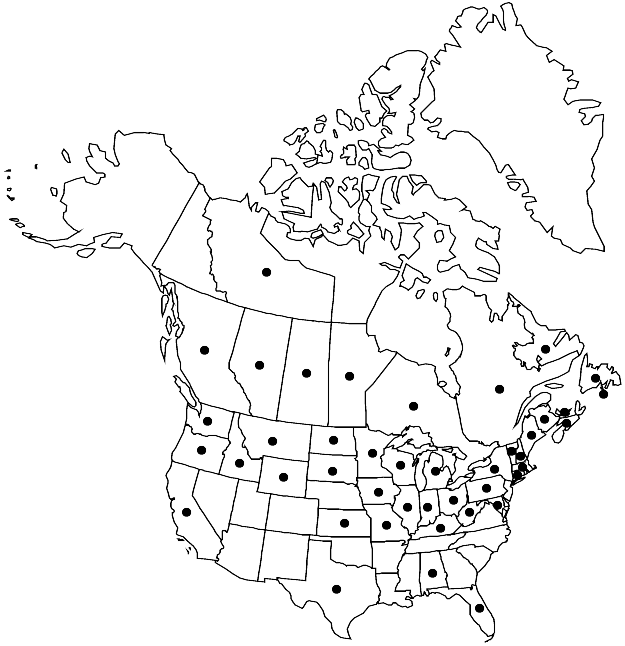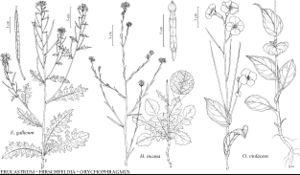Difference between revisions of "Erucastrum gallicum"
Bot. Jahrb. Syst. 54(Beibl. 119): 56. 1916.
FNA>Volume Importer |
FNA>Volume Importer |
||
| Line 30: | Line 30: | ||
|elevation=0-2000 m | |elevation=0-2000 m | ||
|distribution=St. Pierre and Miquelon;Alta.;B.C.;Man.;N.B.;Nfld. and Labr.;N.W.T.;N.S.;Ont.;P.E.I.;Que.;Sask.;Ala.;Calif.;Conn.;Fla.;Idaho;Ill.;Ind.;Iowa;Kans.;Ky.;Maine;Md.;Mass.;Mich.;Minn.;Mo.;Mont.;N.H.;N.Y.;N.Dak.;Ohio;Oreg.;Pa.;S.Dak.;Tex.;Vt.;Wash.;W.Va.;Wis.;Wyo.;Europe. | |distribution=St. Pierre and Miquelon;Alta.;B.C.;Man.;N.B.;Nfld. and Labr.;N.W.T.;N.S.;Ont.;P.E.I.;Que.;Sask.;Ala.;Calif.;Conn.;Fla.;Idaho;Ill.;Ind.;Iowa;Kans.;Ky.;Maine;Md.;Mass.;Mich.;Minn.;Mo.;Mont.;N.H.;N.Y.;N.Dak.;Ohio;Oreg.;Pa.;S.Dak.;Tex.;Vt.;Wash.;W.Va.;Wis.;Wyo.;Europe. | ||
| − | |discussion=<p>A European native, Erucastrum gallicum was first recorded for North America from Massachusetts and Wisconsin (see J. O. Luken et al. 1993 for history of introduction and spread). It is naturalized in all the provinces of Canada and in parts of the United States, particularly the Midwest. It is an allopolyploid, with the n = 7 component from Diplotaxis erucoides/D. cossoniana and n = 8 from the E. nasturtiifolium complex (S. I. Warwick and L. D. Black 1993). I have not seen specimens from Maryland.</p> | + | |discussion=<p>A European native, <i>Erucastrum gallicum</i> was first recorded for North America from Massachusetts and Wisconsin (see J. O. Luken et al. 1993 for history of introduction and spread). It is naturalized in all the provinces of Canada and in parts of the United States, particularly the Midwest. It is an allopolyploid, with the n = 7 component from <i>Diplotaxis erucoides</i>/D. cossoniana and n = 8 from the E. nasturtiifolium complex (S. I. Warwick and L. D. Black 1993). I have not seen specimens from Maryland.</p> |
|tables= | |tables= | ||
|references= | |references= | ||
| Line 55: | Line 55: | ||
|publication year=1916 | |publication year=1916 | ||
|special status= | |special status= | ||
| − | |source xml=https://jpend@bitbucket.org/aafc-mbb/fna-data-curation.git/src/ | + | |source xml=https://jpend@bitbucket.org/aafc-mbb/fna-data-curation.git/src/8f726806613d60c220dc4493de13607dd3150896/coarse_grained_fna_xml/V7/V7_656.xml |
|tribe=Brassicaceae tribe Brassiceae | |tribe=Brassicaceae tribe Brassiceae | ||
|genus=Erucastrum | |genus=Erucastrum | ||
Revision as of 17:59, 18 September 2019
Plants sparsely to densely pubescent, trichomes stiff, recurved (or retrorsely appressed). Stems erect or ascending, unbranched or branched (few to several), 0.9–6.5(–8) dm. Basal leaves: blade oblanceolate, 3–28 cm × 8–110 mm, margins dentate to deeply lobed or pinnatifid, lobes 3–10 each side, smaller than terminal, lobe margins crenate or dentate, surfaces sparsely pubescent. Cauline leaves similar to basal, distal shortly petiolate or sessile, blade smaller (distalmost 1–2 cm, passing into bracts, leaflike, linear, margins entire). Fruiting pedicels (3–)5–10(–20) mm. Flowers: sepals 3–5 × 1–2 mm, sparsely hispid apically; petals white to pale yellow, 4–8 × 1.5–3 mm; filaments 3.5–5.5 mm. Fruits slightly torulose, 1–4.5 cm × 1–2(–2.7) mm; terminal segment 1.5–4 mm; style 1–3 mm. Seeds reddish brown, 1.1–1.5 × 0.7–0.8 mm, alveolate. 2n = 30.
Phenology: Flowering Mar–Sep(-Dec in south, fruiting shortly after).
Habitat: Roadsides, waste places, disturbed sites, along railroads, fields, gardens, orchards, beaches of Great Lakes
Elevation: 0-2000 m
Distribution

St. Pierre and Miquelon, Alta., B.C., Man., N.B., Nfld. and Labr., N.W.T., N.S., Ont., P.E.I., Que., Sask., Ala., Calif., Conn., Fla., Idaho, Ill., Ind., Iowa, Kans., Ky., Maine, Md., Mass., Mich., Minn., Mo., Mont., N.H., N.Y., N.Dak., Ohio, Oreg., Pa., S.Dak., Tex., Vt., Wash., W.Va., Wis., Wyo., Europe.
Discussion
A European native, Erucastrum gallicum was first recorded for North America from Massachusetts and Wisconsin (see J. O. Luken et al. 1993 for history of introduction and spread). It is naturalized in all the provinces of Canada and in parts of the United States, particularly the Midwest. It is an allopolyploid, with the n = 7 component from Diplotaxis erucoides/D. cossoniana and n = 8 from the E. nasturtiifolium complex (S. I. Warwick and L. D. Black 1993). I have not seen specimens from Maryland.
Selected References
None.
